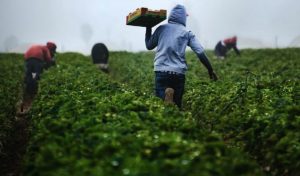Differences Between Subsistence and Commercial Agriculture: Agriculture remains one of the strongest footholds of the world’s economy. Ranging from the different types of food we eat which varies from place to place, to the clothes we wear, and down to the shoes we wear and even almost every manufactured or produced asset around us. Most of these are possible as a result of agriculture.

Thus, agriculture has been a one time major contributor of some nations’ growing economy both within and between the borders of nation to nation. Nigeria was one country that had agriculture as one of its greatest sources of income, until the discovery of oil and gas in the country. And of course, this has been the same narrative for some other countries as well.
This article attempts to x-ray the major differences between the two types of agriculture, namely; subsistence agriculture and commercial agriculture.
Recommended: Doctors and farmers, who are more important in the society? (Answered)
What is Agriculture?
Agriculture is the science or practice of farming, including cultivation of the soil for the growing of crops and the rearing of animals.It is based on the geographical conditions, level of technology, the demand for products and workers required for farming that agriculture is then divided into subsistence agriculture and commercial agriculture.
Meaning of subsistence and commercial Agriculture
Subsistence agriculture can be defined as the kind of farming practice that is done on a small scale for the purpose of local consumption.

Commercial agriculture, from the name, can be easily recognized as the kind of farming practice done for the purpose of getting farm produce in commercial (i.e. very large) quantities.
Also see: How to be a good teacher in school
Characteristics of subsistence agriculture
Some of the characteristics of subsistence agriculture includes:
a. It is labour intensive
b. Usually practiced in rural areas
c. Requires little investment
d. Practiced seasonally
e. Little or no knowledge of soil chemistry
f. Use crude tools
g. Small farm size
h. Lack of storage facilities
I. Low productivity
Characteristics of commercial agriculture
Some of the characteristics of commercial agriculture includes:
a. It is capital intensive
b. The purpose is for trade
c. Practiced in large area
d. Huge investment
e. Labours are both skilled and unskilled
g. High productivity
h. Use of machineries
I. Expensive to manage
J. Need for infrastructure like good roads, electricity and medical facilities.
Also see: Most profitable skills to learn in the world 2022
Advantages and Disadvantages of Commercial and subsistence agriculture
Commercial agriculture on the one hand, has increased the yield of crops but on the other hand it imposed threats to the environment.

Commercial agriculture has the following advantages:
a. Increased production or yield of the rate of crops which add value to the national food stock
b. It improves and increases the infrastructural development in the area where it is practiced e.g. power supply, roads, etc.
c. Prices of agricultural products and goods are lowered as a result of increased production to make them accessible to everyone which in turn helps to meet up with demand and supply.
d. Provides job opportunities.
e. Mode of irrigation is improvised to reduce the cost of production.
f. Takes less time to perform cultivation or farming operations with the use of machineries.
g. Source of raw materials to industries for the production or manufacture of finished products.
Disadvantages of commercial agriculture includes:
a. Land tenure system
b. Negative impact of deforestation to prepare land for farming
c. High cost of maintenance
d. Chemicals used on farm land like fertilizers, insecticides and herbicides become a vivid threat to humankind.
Some advantages of subsistence agriculture are as follows:
a. Requires little investment
b. Is mostly seasonal
c. Is cheap and best effective to maintain
d. No problem with the land tenure system
e. Manures are mostly used, so there’s little or no threat to humankind
f. The size of the farm is usually small, hence no need for deforestation
Disadvantages of subsistence agriculture includes:
a. Low productivity
b. Size of the farm is small
d. Lack of storage facilities
e. Lack of preservation of perishable food products
Recommended: Ways to promote popular participation in politics
Differences Between Subsistence agriculture and Commercial Agriculture
From the definitions and characteristics provided above for both subsistence agriculture and commercial agriculture, some of the major differences between them can be readily spelt out.
1. Purpose: While commercial agriculture is done for the purpose of getting farm produce in terms of crops, grains, livestock and so on, in very large quantities, Subsistence agriculture is carried out just for domestic and local consumption by the family members of the local farmers.
2. Relationship of Farming to Other Businesses: The surplus from subsistence farming are sold in small and nearby markets and they usually do not yield large sums but meager sums for the use of the family members involved in the subsistence farming.
The large quantities produced in commercial agriculture are exported or transported to be sold out in large marketplaces or supplied to distributors of market produce within the country. And usually, generates big income.
3. Labour or Capital Intensive: Subsistence agriculture is labour intensive because only the people involved in the local consumption of the farm produce cultivate and till the lands by themselves, plant, weed, water the farmland, and harvest the farm produce at the end of the day. They make use of manual equipment like hoes, cutlass, sickle, etc. Animal labour is also employed.
Commercial agriculture on the other hand is capital intensive, instead of labour intensive. This is due to the fact that big machinery and equipment are used in the large scale production of both the animal and farm produce that are reared and grown on the farm land.
Recommended: Most difficult courses to study in the university
4. Use of Machineries: Big farming equipment and machinery are used to till the soil, plough the ground, mould ridges, plant seeds, water and harvest farm produce. Some machineries are also used in livestock production, for example, machines that can help to milk cows and goats and even some that help to collect chicken eggs. They include tillers, ploughs, planters, ridger, harvesters, etc.
All this makes for the capital intensive nature of commercial agriculture because a lot of money is spent with the intention of producing in very large quantities for solely generating income in turn.
In subsistence agriculture, there is no use of machinery, only crude tools are used.
5. Productivity Enhancement: Another difference between subsistence agriculture and commercial agriculture is that while subsistence agriculture makes use of only manure mostly gotten from animals, fowls, cow dung, etc, to enhance its productivity, commercial agriculture makes use of higher doses of modern inputs and techniques to enhance its productivity. Some of the techniques could be cross breeding, grafting and so on.
Also see: How to become a successful business entrepreneur
6. Kind of Crops Grown: Furthermore, another difference between subsistence agriculture and commercial agriculture lies in the types or kinds of crops grown on the farm. In commercial agriculture, cash crops are largely grown alongside cereals. Cash crops are majorly not for consumption by the farmers who produce them but are specifically to be sold for profit.
Examples of cash crops include: wheat, fruits, vegetables, corn, cotton, sugarcane, rubber, soyabean and oil producing plants.These are produced in large quantities for the purpose of providing for the needs of the whole population of a country. However, in subsistence agriculture, food grains/crops are mostly grown including fruits and vegetables for local consumption.
7. Area: Subsistence agriculture is usually practiced in less developed countries while commercial agriculture is usually practiced in very developed countries.
Recommended: Types and classification of food
8. Cultivation: In subsistence agriculture, traditional methods of cultivation are used. While modern methods of cultivation are used in the practice of commercial agriculture.
9. Farm Size: The size of land used for farming in subsistence agriculture is usually small because farming is practiced in small patches. But the size of land used in commercial agriculture is usually very large because farming is practiced on a large scale.
10. Percentage of Farmers in Labour Force: The percentage of farmers used in subsistence agriculture is usually very little compared to the percentage of farmers used in commercial agriculture. This is because only family members are used to provide labour on the farm land.
In commercial agriculture, the percentage of labourers hired is higher because the scale of farming is large
Recommended: How to start a business with small capital and be successful
Conclusion
Developed countries mostly operate commercial agriculture to take care of their needs. But, developing countries, like Nigeria, mostly engage in subsistence agriculture. It is recommended that developing countries should engage in commercial agriculture to provide for themselves and to improve the nation’s economy.
This is moreso because a developing country which has its major source of income from the exploration and exploitation of oil and gas may suffer from lack when such natural resources become exhausted in the long run. Safe agricultural practices are also well encouraged in the practice of commercial agriculture.

Edeh Samuel Chukwuemeka, ACMC, is a lawyer and a certified mediator/conciliator in Nigeria. He is also a developer with knowledge in various programming languages. Samuel is determined to leverage his skills in technology, SEO, and legal practice to revolutionize the legal profession worldwide by creating web and mobile applications that simplify legal research. Sam is also passionate about educating and providing valuable information to people.
Nice write up. It this was so helpful.